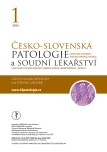Parathyroid tumors in the 5th edition of the WHO Classification of Tumors of the Endocrine Organs
Authors:
Dušková J.
Published in:
Čes.-slov. Patol., 60, 2024, No. 1, p. 68-70
Category:
Reviews Article
Overview
The diagnosis of pathological conditions of the parathyroid glands is the answer to clinically more frequently detected hypercalcemic conditions, including MEN syndromes. In routine biopsy practice, enlarged bodies are also a differential diagnosis for the diagnosis of thyroid nodules.
In the chapter of parathyroid tumors, the 5th edition of the WHO classification brings changes influenced similarly to other endocrine organs by the increase in genetic information. At the terminological level, the concept of hyperplasia has been narrowed down to secondary hyperplasia, most of the previously primary hyperplasias are referred to as multiglandular parathyroid disease due to evidence of multiglandular clonal proliferations. The term atypical parathyroid tumor replacing atypical adenoma is newly introduced - the uncertain biological behaviour is emphasized. The basic examination includes parafibromin immunohis- tochemistry, the deficiency of parafibromin being an indicator of an inactivating CDC73 mutation and an increased risk of familial forms, or MEN. Methodologically, refinements are introduced in the quantification of mitotic activity per 10 mm2. Oncocytic subtypes have an arbitrarily declared threshold of more than 75% oncocytes. The definition of lipoadenoma (multiplication of both components, more than 50% of adipose tissue in the tumor) is similarly specified. The diagnosis of cancer remains histopathological with unequivocal evidence of invasion, or microscopically verified metastasis.
Keywords:
hyperparathyroidism – WHO classification of parathyroid tumors – parathyroid tumors – multiglandular parathyroid dinase – atypical parathyroid tumor – parathyroid carcinoma – thyroid nodule biopsy
Sources
- Cave AJE. Richard Owen and the discovery of the parathyroid glands. In: Underwood EA, ed. Science, medicine and history. Essays on the evolution of scientific thought and me- dical practice. Vol. 2. Oxford University Press; 1953: 217–222.
- Fehrenbach MJ, Herring SW. Illustrated ana- tomy of the head and neck (4th ed.). St. Louis, Mo: Elsevier/Saunders; 2012.
- Erdheim J. Beiträge zur pathologichen Ana- tomie der menschlichen Epithelkörpechen Zeitschr f Heilk 1904; 25: 1-15.
- Kalra S, Baruah MP, Sahay R, Sawhney K. The history of parathyroid endocrinology. In- dian J Endocrinol Metab 2013; 17(2): 320-322.
- Williams ED, Siebenmann RE, Sobin LH. Histological typing of endocrine tumours. Geneva: 1980.
- Delellis RA, Lloyd RV, Heitz PU, Eng C. World health organization classification of tumours. Pathology & genetics of tumours of endocrine organs. Lyon: IARC Press; 2004.
- Lloyd RV, Osamura R, Klöppel G, Rossai JE. WHO classification of tumours of endocrine organs (4th ed.). Lyon: IARC; 2017.
- WHO Classification of Tumours Editorial Board. Endocrine and neuroendocrine tumours [Internet]. Lyon (France): International Agency for Research on Cancer; 2022 [cited 2023 08 20]. (WHO classification of tumours series, 5th ed.; vol. 10). Available from: https:// tumourclassification.iarc.who.int/chapters/53
- Duan K, Gomez Hernandez K, Mete O. Cli- nicopathological correlates of hyperparathy- roidism. J Clin Pathol 2015; 68(10): 771-787.
- Erickson LA, Mete O, Juhlin CC, Perren A, Gill AJ. Overview of the 2022 WHO classifi- cation of parathyroid tumors. Endocr Pathol 2022; 33(1): 64-89.
Labels
Anatomical pathology Forensic medical examiner ToxicologyArticle was published in
Czecho-Slovak Pathology

2024 Issue 1
Most read in this issue
- Histopathology of skin melanocytic lesions
- Mesenchymal skin tumors – Novel entities in the 5th edition of WHO classification of skin tumors
- Clinical, Morphological and Molecular Features of Spitz tumors
- Changes in the diagnosis of thyroid tumours in the 5th edition of the WHO classification of endocrine neoplasms
